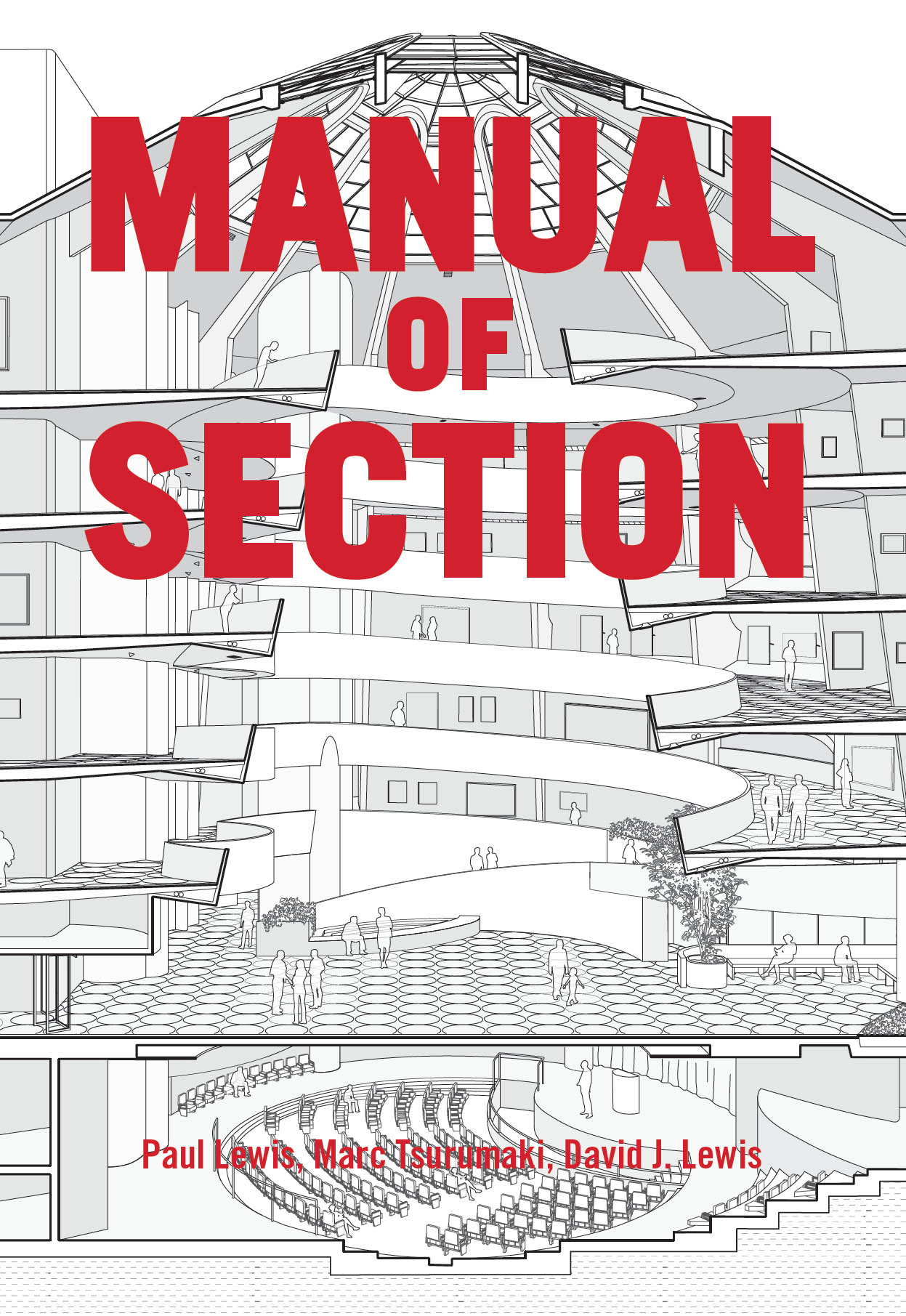Paul Lewis - Manual of Section
Here you can read online Paul Lewis - Manual of Section full text of the book (entire story) in english for free. Download pdf and epub, get meaning, cover and reviews about this ebook. year: 2016, publisher: Princeton Architectural Press, genre: Romance novel. Description of the work, (preface) as well as reviews are available. Best literature library LitArk.com created for fans of good reading and offers a wide selection of genres:
Romance novel
Science fiction
Adventure
Detective
Science
History
Home and family
Prose
Art
Politics
Computer
Non-fiction
Religion
Business
Children
Humor
Choose a favorite category and find really read worthwhile books. Enjoy immersion in the world of imagination, feel the emotions of the characters or learn something new for yourself, make an fascinating discovery.

- Book:Manual of Section
- Author:
- Publisher:Princeton Architectural Press
- Genre:
- Year:2016
- Rating:3 / 5
- Favourites:Add to favourites
- Your mark:
- 60
- 1
- 2
- 3
- 4
- 5
Manual of Section: summary, description and annotation
We offer to read an annotation, description, summary or preface (depends on what the author of the book "Manual of Section" wrote himself). If you haven't found the necessary information about the book — write in the comments, we will try to find it.
Manual of Section — read online for free the complete book (whole text) full work
Below is the text of the book, divided by pages. System saving the place of the last page read, allows you to conveniently read the book "Manual of Section" online for free, without having to search again every time where you left off. Put a bookmark, and you can go to the page where you finished reading at any time.
Font size:
Interval:
Bookmark:


This book presents the means for understanding the complex and important role that section plays in architectural design and practice. Discussion and debate of a particular buildings section are common in the study and practice of architecture. Yet there is no shared framework for the determination or evaluation of section. What are the different types of section, and what do they do? How does one produce those sections? Why would one choose to use one configuration of section over another? This book explores these questions and provides a conceptual, material, and instrumental framework for understanding section as a means to create architecture.
Our work has been motivated by the belief that the architectural section is key to architectural innovation. Given the environmental and material challenges that frame architectural practice in the twenty-first century, the section provides a rich and underexplored opportunity for inventively reimagining the intersection of structural, thermal, and functional forces. Moreover, the section is the site where space, form, and material intersect with human experience, establishing most clearly the relationship of the body to the building as well as the interplay between architecture and its context.
As practitioners and educators, we are invested equally in section as a type of representation and as a projective tool for spatial and material invention. We offer with this book a clear heuristic structure for a more robust discourse around the architectural section, to establish a shared basis for dialogue toward explorative and experimental architecture. Newly generated section perspectives of sixty-three significant built projects, organized into seven distinct types, provide students, architects, and other readers with a foundation for further cultivation of the section.

LTL Architects, Park Tower, 2004
We begin with the seemingly obvious question What is a section? In reference to architectural drawing, the term section typically describes a cut through the body of a building, perpendicular to the horizon line. A section drawing is one that shows a vertical cut transecting, typically along a primary axis, an object or building. The section reveals simultaneously its interior and exterior profiles, the interior space, and the material, membrane, or wall that separates interior from exterior, providing a view of the object that is not usually seen. This representational technique takes various forms and graphic conceits, each developed to illustrate different forms of architectural knowledge, from building sections that use solid fill or poche to emphasize the profile of the form, to construction details that depict materials through lines and graphic conventions. In an orthographic section the interior is also described through interior elevations of the primary architectural surfaces, while the combination of a section with a perspective describes in depth the interior as a space, using the techniques of perspectival projection.
Because the section begins with the visualization of that which will not be directly seen, it remains abstracted from the dominant way of understanding architecture through photographs and renderings. Sections provide a unique form of knowledge, one that by necessity shifts the emphasis from image to performance, from surface to the intersection of structure and materiality that comprises the tectonic logic of architecture. At the same time, section demonstrates the exchange among multiple aspects of embodied experience and architectural space, making explicit the intersection of scale and proportion, sight and view, touch and reach that is rendered visible in the vertical dimension (as opposed to from top down). In a section, the interior elevations of walls and surfaces are revealed, combiningfor examination and explorationstructure and ornament, envelope and interior.
Plans and sections are similar representational conventions and offer an important point of comparison. Both depict a relationship that is not directly perceivable by the human eye, between a buildings mass and the space. Both describe cutsthe one horizontal, the other vertical. The horizontal division of a plan cuts primarily through walls, not floors. Sections, on the other hand, are capable of showing cuts through both walls and floors and organize space in alignment with the size and scale of the standing human figure. Plans are typically argued to be the locus of design agency, with sections understood as a means to manifest the effects of the plan through structure and enclosure. In comparison to plan types, which are distinguished by their spatial consequences, section types are usually identified by the scale of their cut: site sections, building sections, wall sections, detail sections. Wall and detail sections foreground technical concerns, using graphic conventions of line, hatch, and tone, and depict material systems and tectonics. Site sections emphasize a built forms massing and its relationship with its environment and decrease the role of internal space. But it is in the building section that a number of crucial issues are at play, including the formal, social, organizational, political, spatial, structural, thermal, and technical.
The section is not limited to its status as a representational technique. Today sections are used expansively to illustrate, test, and explore architectural designs. The section illuminates the interplay between a buildings structure and the space framed between foundation and roof. Gravitational loads of structure trace vertically down through a building, with wind loads registering laterally against the side of a buildings section. The material investment and spatial invention necessary to creatively resist these loads is best explored and depicted through the architectural section.
As questions of energy and ecology have become increasingly important to architectural design, the section will take on a more prominent role. Thermal forces work in section. Cold air is heavier and settles, while hot air rises. The sun rises and falls against the horizon. The vertical calibration of space is essential for inventing and creating architecture to engage environmental performance. Architects need to calibrate overhangs and apertures to produce the optimal solar radiation; interiors should be configured to maximize convection-driven air movement; roof pitches need to be set to ensure the efficiency of solar panels; wall thickness must be dictated by insulation calculations; and so on. Often driven by a desire to meet sustainable certification criteria, architects and engineers use section drawings to illustrate adherence to conventions of thermal performance, with arrays of arrows illustrating thermodynamic forces. This emphasis on thermal efficiency foregrounds the opportunities of the section, but paradoxically constrains the spatial and experiential potential of the section by aligning sectional innovation to only functional obligations.
Yet, despite the importance of section as a drawing type and as a key method for optimizing spatial qualities, structural design, and thermal performance, there is a relative paucity of critical writings or discourse on section. A well-established body of writing exists on the history and impact of the plan, but there is no single book on the history, development, and use of the section within the practice of architecture. Only a few essays on section have been published, with the two most often cited written more than twenty-five years ago: Wolfgang Lotzs The Rendering of the Interior in Architectural Drawings of the Renaissance Interestingly, both essays have parallel motives beyond cultivating and describing the architectural section itself.
Next pageFont size:
Interval:
Bookmark:
Similar books «Manual of Section»
Look at similar books to Manual of Section. We have selected literature similar in name and meaning in the hope of providing readers with more options to find new, interesting, not yet read works.
Discussion, reviews of the book Manual of Section and just readers' own opinions. Leave your comments, write what you think about the work, its meaning or the main characters. Specify what exactly you liked and what you didn't like, and why you think so.










